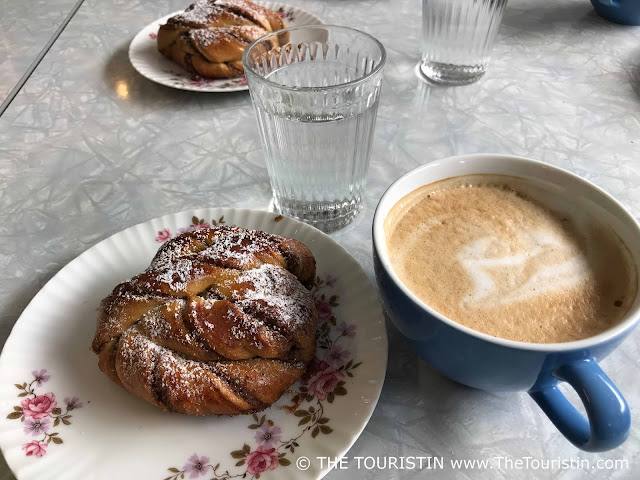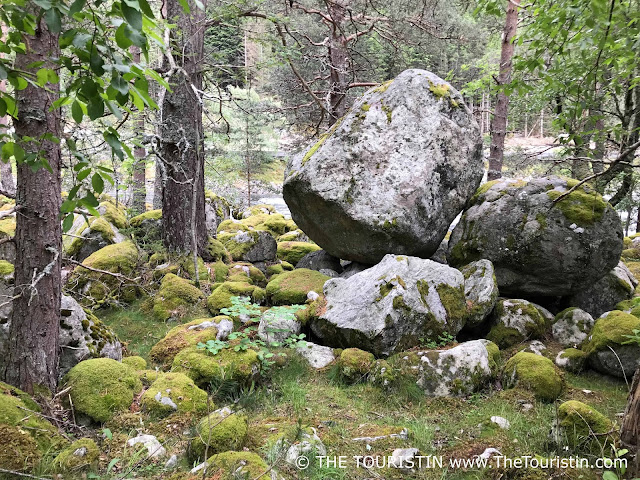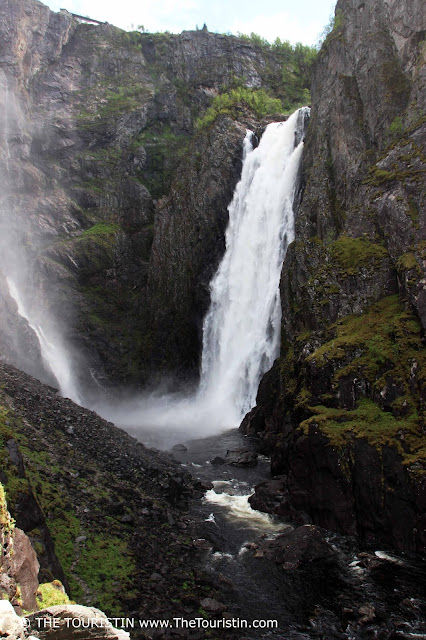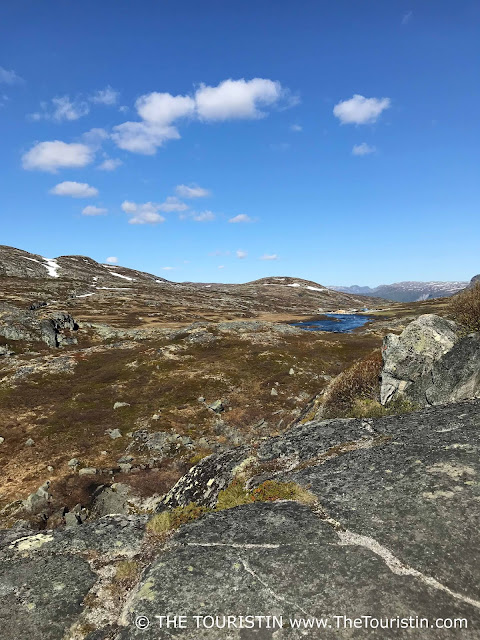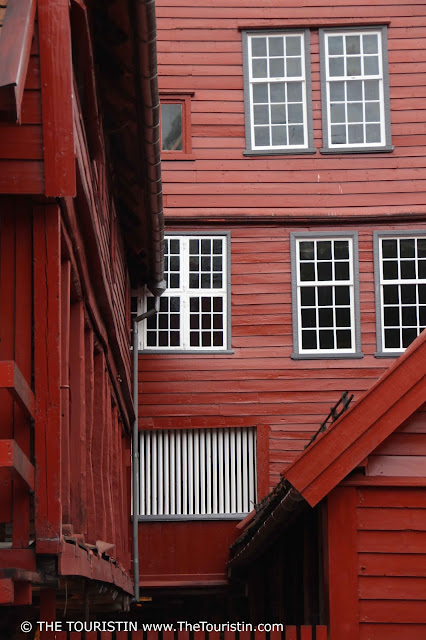When
you pick up your rental car to go on a road trip through Norway, you
drive for hours and seemingly endlessly through thick forests and along
rivers, and fjord after fjord, after fjord. One can imagine that this
land must be full of funny looking trolls living on trees and in between
rocks and cliffs and all over Norway's wild and isolated mountainous
plateaus.
The
Kingdom of Norway, the Scandinavian country of mountains, glaciers and
coastal fjords shares borders with Sweden, Finland, Russia, and Denmark.
It has an extensive coastline along the North Atlantic Ocean, the North
Sea, and the Barents Sea.
Norge, in English Norway, with a population of about 5,000,000 has got 1,190 fjords. You know a fjord is one of these long, deep, narrow inlets of the sea, or a lake drain which extends inland in the form of a deep valley. When you fly into the capital Oslo what you see from above is a sea of fjords, rivers, lakes and pine trees. And what you see is what you get.
What you experience and find here in Norway might as good as well come from another galaxy. The land you drive through is lush, wild and green. Norway’s seemingly untamed beauty is indeed almost unreal. A high number of fjords is connected. There isn't a moment where you wouldn't look at a fjord, a river, or a waterfall, small or large. After heavy rainfall, there are even more waterfalls, rushing down the high cliffs. Water gurgles and floats all around you and around every turn you take.
It makes total sense that almost all of Norway's power usage stems from hydroelectric power plants. Hydroelectric power? Generating energy that way sounds perfect. The downside is that the construction of dams, hydroelectric plants, and wind farms threatens Norway’s wild reindeer's natural habitat. They simply don't fancy to be near new roads, power lines, or dams.
Rent a hybrid car. I am stunned by the massive availability of plug-in stations. Half of all passenger cars sold in Norway in 2018 were either all-electric or plug-in hybrids, and the top-selling car that year was the all-electric Nissan Leaf. No surprise then to learn that Norway plans to end sales of all fuel-powered cars by 2025. Read more about it in Quartz Magazine. This is no advertising. I am just fascinated by the fact of how advanced Norway is.
Norwegians are welcoming, open and friendly people, on hikes you wouldn't meet a person that would not greet you with a "hei hei," a friendly hello. This might have got to do with the fact that they have to have their annual income, income tax paid, and total wealth published to be seen by everyone living in Norway. Why would you not greet the ones who know so much about you already? That type of openness is so hard to imagine in most countries.
Eidfjord – A Village in Hordaland County
Eidfjord as a base for some genuinely remarkable excursions in Norway's south region is as excellent as it is laid-back. You find the 900 souls strong Eidfjord in Hordaland county, in the traditional district of Hardanger. The tiny village sits at the end of the Eid Fjord, an arm of the great Hardanger Fjord. Highlights are the lush Måbødalen valley, the mighty Vøringsfossen waterfall, the icy-cold but magical Hardangervidda National Park, and its proximity to colourful Bergen.
Vegetarian-Friendly cafes and restaurants in Eidfjord. Fjell & Fjord Kafe og Kremmeri. Delicious freshly prepared sandwiches and cakes. You can even stock up on Liquorice and buy locally produced goodies to take home. There is a hotel with 28 rooms next door. Fjell & Fjord Kafe og Kremmeri, Riksdagen 29, Eidfjord 5783, Norway.
Experience White Nights in Eidfjord
Twilight. It hardly ever gets dark during the summer months. You can go for a walk through Eidfjord during the night in what feels like daylight, and that already is an adventure. A rather quiet adventure. The following photos are taken during the night.
In the middle of June days are like this: Civil twilight begins (Dawn) 1.55am, Sunrise 4.01am, Sunset 11.04pm, Civil twilight ends (Dusk) 1.10am. If you aren't too cold, you can sit on the porch and read a book well into the night and with no need for artificial light.
Travel all the way up to Northern Norway around the summer solstice. There you will see that the sun is out for a full 24 hours.
Hæreid – Viking Burial Mounds
One of the things Norway is most famous for is the Vikings. The period that the Vikings ruled in Norway is believed to be from around 800 to 1066 when most of the Vikings lived in coastal areas to farm and fish. Talking about Vikings, most of us think of brutal aggressors, but they were also great explorers and traders. Always searching for suitable farmland in Northern Europe, they brought home Christianity from their raids in England and the Frankish kingdoms. Until that point, they worshipped Nordic gods, as Thor and Odin. Olaf I of Norway converted first to the new religion, and his successor managed to convert (sort of) the whole of the country to it.
Go on the roughly one to two hour-long walk from the centre of Eidfjord (yellow route). If you walk over the bridge and along the fast flowing and short river Eio, stop first at the moraine-dammed Lake Eidfjord (Eidfjordvatnet). Have a picnic on the beach of the lake (if the weather plays along). Bring your own water and snacks and take all rubbish home with you.
Walk on to visit Hæreid. Trees covered in moss. Silence. Bird song plus the sound of the near river. When you walk through the forest, it looks and feels as if time stands still. You reach the plateau after an easy, slightly steep walk up a hill. Pagans buried their dead with grave goods during the Iron-and Viking ages. How many of the 400 burial mounds found up here can you spot? The mounds are made from light-grey round boulders and are overgrown with grass and moss. The grave sites are signposted.
As you walk further on Hereidsvegen, you get the chance to take photos of cute farmhouses which have grass grown on their roofs. After a short while, follow the sign towards the viewing point over Eidfjord. From here it is only a ten minutes’ walk down the hill back to the village.
The Eid Fjord – the innermost part of the Hardanger Fjord
A fjord looks like any other enormous freshwater lake but consists of saltwater. If you stand on its shore, you feel so small, with imposing cliffs towering above on both sides. The queen of all Fjords is Sognefjord in Western Norway, it is 205 kilometres in length, 4,5 kilometres in width and 1,308 metres deep. Can you imagine? Impressive. The Geirangerfjord and the Nærøyfjord are UNESCO World Heritage listed.
10,000 years ago, enormous glacial ice started to melt. As the Scandinavian land mass started to rise, lower parts of the valley became flooded, and the 860 metres deep Hardanger Fjord was born. It starts at the Atlantic Ocean, 80 kilometres south of Bergen, and runs its course over 179 kilometres all the way to the mountainous interior along the Hardangervidda plateau. One arm of the second longest fjord in Norway and the fourth longest fjord in the world is the Eid Fjord.
Vøringsfossen Waterfall
Norway's most famous waterfall has a free fall of 145 metres, and from the Hardangervidda plateau into the Måbødalen (Måbø Valley) a total fall of 182 metres. You can either hike down into the canyon or enjoy the view from the Fossli Hotel. Why not do both?
Vøringsfossen Waterfall from the Fossli Hotel
You reach the viewing platform in front of the signposted Fossli Hotel after a short drive from the Rv7. You are going to share the viewing platform at the waterfall with other road-tripping tourists, and coachloads of cruise ship passengers. It is busy, most visitors to the viewing platform just stay for a few minutes to take their obligatory "I-was-here-photo". The view over the waterfall and Måbødalen valley is a beautiful one.
Fossli Hotel. Off Norwegian National Road 7. Voringsfossen, 5783, Norway.
Hike to Vøringsfossen Waterfall
The walk is only 1.2 kilometres long. It sounds easy to manage, and it is, but only if you are stable on your feet and bring with you a certain amount of fitness and flexibility. This is not a hike over a gravel trail but rather a hike/climb over rocks (some unstable). You would need to be able to jump from boulder to boulder, and occasionally you would also need to have a head for heights. For the return-walk, calculate roughly two hours. That is definitely the case if you take photos along the way and spent a bit of time at the waterfall. The trail is open from June to September (when it is snow free).
You can leave your car on the Norwegian National Road 7, at a place called Storegjel, that lies between the 2nd and the 3rd tunnel of the Måbøtunnel. It is easy to miss. From there you walk along the old (unused) tarred road for 300 metres. As soon as you reach the first turn you see a sign to “Vøringsfossen,” and this is where you start the downhill hike/climb towards the river Bjoreio.
Follow the rocky trail towards the waterfall. Rocks are slippery due to the spray from the waterfall. Red arrows painted onto the rocks clearly mark the trail. As you come down to the river, you reach a suspension bridge. Cross it and keep on walking. If you follow the path along the river, you get a good view of the waterfall. Bring your own water and snacks and take all rubbish home with you.
Walk/climb the exact way back to your car.
Scenic Route - Hardangervidda Mountain Plateau
It takes only 40 minutes to drive from Eidfjord to the remoteness of the 1,250 high Hardangervidda mountain plateau. At 8,000 km², Hardangervidda is not only Norway’s largest national park, but also Europe’s largest high-altitude plateau. If you drive the 67 kilometres from Eidfjord to Haugastøl in Hardangervidda, you experience the vast beauty of the National Park. There are lots of places where you can park your car to go for short walks. This is an excellent place to admire the scenery. This region is considered to be the southern boundary of several arctic plants and animals, notably the mountain fox and snow-owl. Wild reindeer, who once roamed free all over Europe, still live on Hardangervidda. Elks, beavers and deers also call the plateau home. Visit the website for more information.
Brightly coloured Bergen
From Eidfjord you can go on a day trip to Bergen within a two and a half hours drive. Be prepared to see breathtaking scenery and lots of darkness in long tunnels. I can only imagine how much power is needed to light out all these tunnels and to ventilate them. Bergen is, after Oslo, Norway's second largest city. Seven mountains surround the city centre. Many of Bergen's locals live in colourful houses that climb up these hills. Walk all the way up to be rewarded with a pretty view over the sea, the Hanseatic Wharf, and the popular and busy fish market.
The town was founded more than 900 years ago whereas one can trace its history way back beyond the Viking Age. As one of the members of the Hanseatic League, Bergen was for several hundred years a flourishing centre of trade between Norway and Europe. The Hanseatic League protected and controlled trade in the region. They set up trade regulations and taxes for all the merchant guilds, where all trade partners had to operate within the framework of the Hanseatic League. Other members of the Hanseatic League were Riga in Latvia, Gdansk in Poland and Luebeck in Germany. Bryggen, the Hanseatic Wharf of Bergen, saved from disrepair, and today UNESCO heritage listed, is one remainder from this time. It is cute to look at, like straight from a fairy-tale.
Vegetarian-Friendly Fine Dining in Bergen
Colonialen 44. Traditional Norwegian food influenced by international cuisine. The focus lies on seasonal cooking and ingredients are sourced from local farmers and producers. Visit the website for more info. Colonialen 44, Kong Oscars gate 44, Bergen. // Restaurant 1877. Norwegian food that focuses on Western Norway’s agricultural traditions. Ingredients are sourced from local suppliers. Read this for more info. Restaurant 1877, Kjøttbaseren, Vetrlidsallmenningen 2, 5014 Bergen.
What you need to know to travel to Norway
As an oil-rich nation, the country relies on the oil industry to support the country’s social welfare, education and cultural programs. Not only that, but Norway has also the largest reserves of natural gas in Europe after Russia, with the petroleum sector the backbone of Norway’s economy. As a result, Norway is one of the top European countries in emissions per capita. That is a serious situation for any country to be in that wants to be a great home also for future generations.
Norway understands that sustainability can reduce problems of climate change and started to act. A lot gets invested in creating a green future. The country works, together with partners, on plans to create hybrid electro planes. In 2019, Oslo holds the title of European Green Capital. Most of the (in Norway) registered cars are electro (the government supports this with incentives).
How to get to Norway and Eidfjord
You can hop on a non-stop flight from most major capital cities to either Oslo Airport in Gardermoen or Flesland Airport in Bergen. Visit the website of the airports, to see which airlines fly directly to these towns. Get a rental car at the airport and drive to Eidfjord (five to six hours).
Visa requirements for Norway
Visitors from the Schengen countries do not need a passport or visa, only a valid an ID-card or passport. Citizens of some countries outside the EU/EEA have to apply for a visitor's visa. Visit udi.no for more detailed information.
Wi-fi in Norway
You can get free Wi-fi in restaurants, cafés etc.
How to change money in Norway
You can pay almost everywhere with a credit card, and there are also lots of ATM’s in the centre of large towns. The currency in Norway is the Norwegian Krone.
Best time to travel to Eidfjord
Eidfjord is a year-round destination if you like the dark winter months. Due to the Gulf Stream, the climate is moderate with lots of rainfall all year round. In spring, from March to May, the snow melts and there are spring flowers everywhere. In summer, June to August, days are long, and temperatures are mild. In autumn, September to November, the weather starts to get cold and days get shorter. In winter, from December to February, the nights are long, there is hardly any daylight, but one can see the Northern Lights in the north.
June to September are both lovely months for hiking. Even in summer it hardly ever gets above 20 degrees Celsius. Winters bring lots of snow, that sort of weather can last well into April and May (bring warm clothes, as in beanie, gloves, puffer jacket (cruelty-free) or woollen coat, winter boots).
What language do they speak in Norway?
The official language in Norway is Norwegian. I have yet to meet a person in Norway who doesn’t speak English.
Hotels which are directly in the centre of Eidfjord
Quality Hotel Vøringfoss. Check the websites for more info.
From Berlin with love




